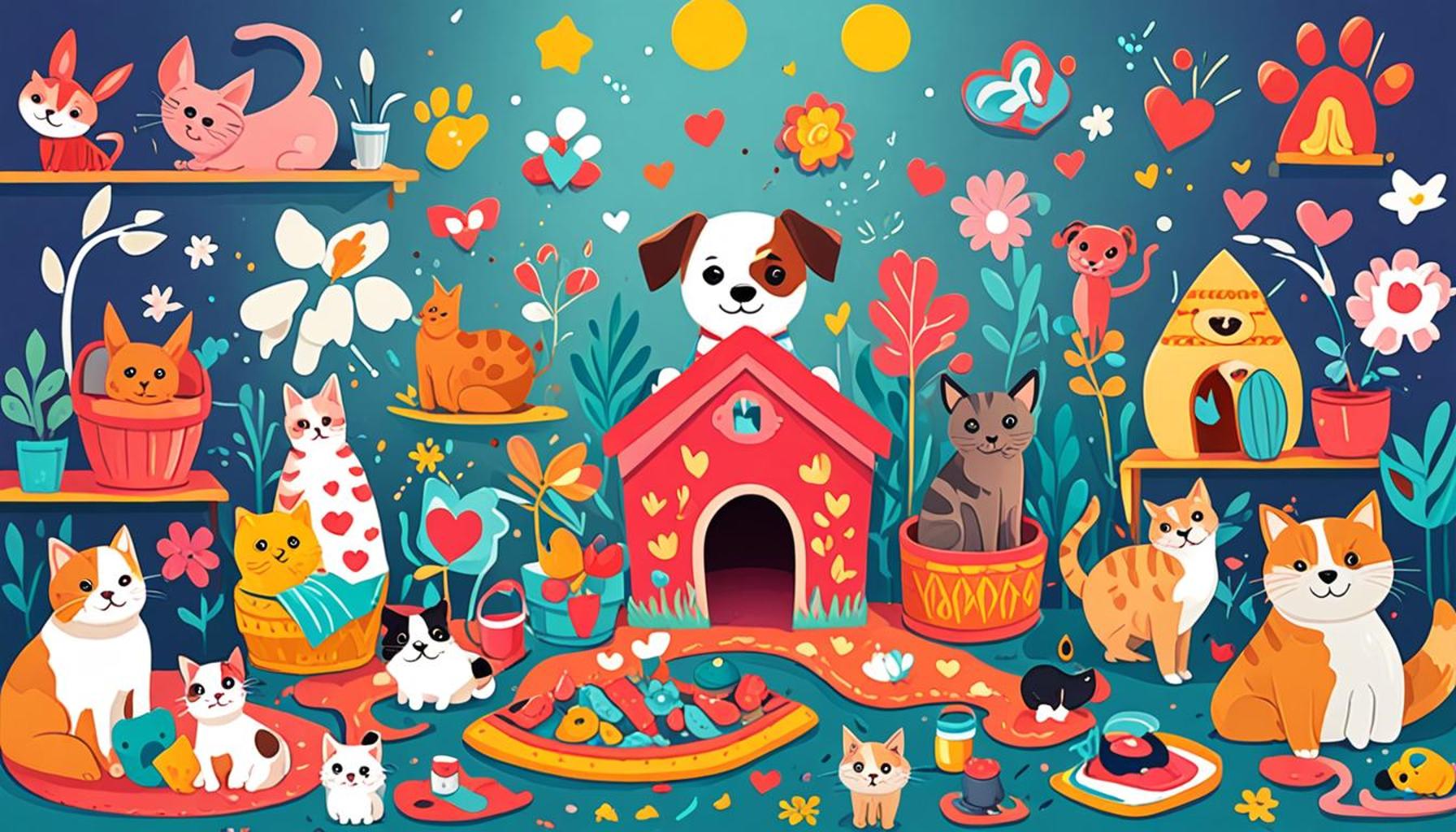The Relationship between Pets’ Mental Health and Environmental Enrichment: Creating Daily Stimuli

The Essential Role of Environmental Enrichment in Pet Mental Health
A pet’s well-being extends beyond basic care. Just like humans, our furry friends require psychological stimulation to thrive. The importance of environmental enrichment cannot be overstated when it comes to maintaining a pet’s mental health.
Providing engaging activities and stimulating surroundings helps prevent behavioral issues and fosters a happier, more balanced life. Pets, just like children, need challenges to engage their brains and bodies. Key benefits of enriching a pet’s environment include:
- Reducing boredom and destructive behavior: Pets often act out by chewing furniture, digging, or barking excessively when they lack sufficient mental and physical challenges. By implementing enriching activities, owners can significantly decrease these disruptive behaviors.
- Encouraging natural instincts such as hunting and foraging: Many animals, including dogs and cats, have innate instincts that, if left unfulfilled, may lead to frustration. For example, cats love to climb and scratch. Creating vertical spaces and introducing scratching posts mimics their natural environment and satisfies their instincts.
- Improving emotional health and reducing anxiety: Pets, particularly dogs, can develop anxiety due to lack of stimulation or routine changes. Implementing variety in their daily activities helps to boost their confidence and comfort in their surroundings.
Examples of effective environmental enrichment are varied. Simple strategies can be both accessible and impactful. Here are some activities to consider:
- Interactive toys that challenge pets mentally: Toys that require problem-solving can engage your pet’s cognitive skills. Brands like Kong and Nina Ottosson offer a range of products that promote critical thinking and reward with treats, making playtime both fun and beneficial.
- Outdoor walks in different environments: Instead of the same neighborhood stroll, take your dog on hikes, visit dog parks, or even let them explore varying terrains. New sights, smells, and experiences not only enhance their mental stimulation but also provide excellent physical exercise.
- Utilizing puzzle feeders to stimulate feeding routines: These feeders not only slow down fast eaters but also encourage pets to work for their food, mimicking natural foraging behavior, thereby keeping their minds engaged.
As pet owners, understanding the intricate connection between pets’ mental health and their surroundings is vital. Providing varied and enriching experiences ensures that our pets remain lively, engaged, and content. By creating daily stimuli, we don’t just fill their time; we enrich their lives and strengthen our bond with them. Explore local resources, connect with pet behaviorists, or investigate online communities to discover further strategies on how you can enhance your pet’s environment and overall well-being!
DISCOVER MORE: Click here to learn about the vital role of animal adoption organizations
The Impact of Environmental Stimulation on Pets’ Behavior
Understanding the relationship between pets’ mental health and environmental enrichment is not just an academic pursuit; it is crucial to the lifelong happiness of our beloved companions. Pets thrive in environments that engage their senses and challenge their intellect. Research shows that animals subjected to monotonous environments are more likely to display anxiety, depression, or behavioral problems. Thus, knowingly or unknowingly, many pet owners may be contributing to the negative mental states of their pets by failing to offer stimulating experiences.
The question then arises: what constitutes effective environmental enrichment? Enrichment goes beyond toys and treats; it encapsulates the entire habitat where a pet lives. It involves creating varied and stimulating environments that cater to a pet’s instincts and natural behaviors. Here are some essential components to consider:
- Variety of Physical Structures: A variety of climbing surfaces, tunnels, and hiding spots can cater to a pet’s exploratory instincts. Cats, for instance, benefit greatly from vertical space, while dogs can enjoy agility equipment or engaging play structures.
- Sound and Visual Enrichment: Changing the auditory and visual landscape of a pet’s environment can stimulate their senses. Playing nature sounds, providing birds at the window as live entertainment, or even rotating visual stimuli can keep their alertness high and boredom at bay.
- Interactive Socialization: Regular interactions with both humans and other animals can alleviate loneliness and stimulate a pet mentally. Consider playdates with other pets or enrolling in training classes that incorporate group activities.
Moreover, the implementation of enriching factors varies significantly based on the species and individual temperament of the pet. For dogs, which are highly social animals, regular visits to dog parks or playgroups can serve dual purposes: exercise and social fulfillment. On the other hand, solitary creatures like cats may require more tailored experiences. Introducing new toys or scents on a regular basis can ignite their curiosity and keep their minds active.
It is essential to understand that environmental enrichment should be adaptable. What works well today may not hold a pet’s interest tomorrow. Therefore, pet owners must be observant and willing to change routines, activities, and settings to keep their pets engaged. Whether engaging in physical activities or offering mental puzzles, the goal is clear: to create a stimulating environment that fosters mental health and enhances overall quality of life.
Ultimately, recognizing the need for constant mental stimulation allows pet owners to create an environment that meets their pets’ physical, emotional, and psychological needs. By focusing on varied daily activities, the bond between pets and their owners deepens and flourishes, laying the groundwork for a happy and healthy life together.
| Category | Key Features |
|---|---|
| Visual Stimulation | Bright toys, moving objects, and colorful environments |
| Cognitive Enrichment | Puzzle feeders and interactive games |
Understanding the link between pets’ mental health and their environments reveals the critical role that daily stimuli play in their overall well-being. Enriching environments not only combat boredom but also promote engagement, which is essential for optimal mental health in pets. Visual stimulation through bright toys and moving objects can captivate pets’ attention, ultimately enhancing their mood and reducing destructive behaviors. The inclusion of cognitive enrichment activities, such as using puzzle feeders and interactive games, challenges their minds, encouraging natural instincts and problem-solving abilities. Research indicates that pets receiving this kind of environmental enrichment exhibit lower stress levels and are less prone to anxiety-related disorders. This means that implementing elements designed to stimulate both the body and mind can lead to healthier, happier animals. Pet owners are encouraged to explore various enrichment options to create an environment that fosters positive mental health outcomes for their furry companions. Such proactive measures can transform a pet’s daily routine into a more fulfilling and stimulating experience, enhancing their quality of life significantly.
DISCOVER MORE: Click here to learn about balanced nutrition for your pet
Innovative Approaches to Environmental Enrichment
As pet owners become increasingly aware of the importance of environmental enrichment for their pets’ mental health, various innovative strategies are gaining traction. The use of technology, for instance, has opened new doors to daily stimuli that can significantly enhance a pet’s living environment.
One highly effective method is the incorporation of interactive toys that challenge and engage pets’ natural instincts. Devices that dispense treats or encourage physical activity are now widely available, ensuring that pets are stimulated while also enjoying a reward system. For example, puzzle feeders, which require pets to manipulate them in specific ways to access their food, provide mental stimulation and promote problem-solving skills. This type of enrichment can transform mealtime into an engaging challenge, drastically reducing boredom.
Additionally, technology such as camera systems and pet monitors allows owners to interact with their pets even when they are away from home. Systems that dispense treats or offer voice commands can help bridge the gap between the pet and owner during those long hours apart. These moments of interaction not only keep animals occupied but provide them with a sense of security and connection as they receive cues from their owners.
Outdoor Enrichment Opportunities
Taking the enrichment outdoors can also provide immense benefits to a pet’s mental health. Committing to regular outings in different environments—whether to a pet-friendly beach, hiking trails, or even urban exploration—offers novel sensory experiences that enrich a pet’s world. Are there local parks with varied terrains? Exploring these can satisfy a dog’s natural desire to sniff and roam, offering mental and physical stimulation that indoor environments often lack.
For cats, the concept of catio or cat patios is growing in popularity. These enclosed outdoor spaces allow cats to experience nature safely while reducing their anxiety associated with outdoor exploration. A carefully designed catio with climbing structures, natural elements, and shade can serve as a stimulating sanctuary that fulfills their innate desires to climb, scratch, and explore.
Seasonal Activities and Variability
Moreover, changing enrichment strategies according to the seasons can help sustain a pet’s interest. In the winter, indoor activities such as hide-and-seek can become an exciting routine, while summer might allow for outdoor games like fetch in a local park. Rotate toys, introduce seasonal scents, or create themed days to keep pets engaged and looking forward to their daily activities. This approach helps combat the issue of habituation, where pets may lose interest in tasks that once fascinated them.
By understanding the diverse possibilities of environmental enrichment, pet owners can foster a multi-dimensional approach to their pets’ mental health. Seeking out new experiences and maintaining a level of adaptability in their routine not only benefits the pets but enhances the bond they share with their owners. Continued exploration and creativity can lead to an enriching environment where pets easily thrive, both mentally and emotionally.
DON’T MISS: Click here to learn more about your pet’s nutritional needs
Conclusion: Prioritizing Pets’ Mental Wellness through Environmental Enrichment
Understanding the intricate relationship between pets’ mental health and environmental enrichment is essential for every pet owner striving to provide a loving and fulfilling environment for their furry companions. As highlighted throughout this exploration, the integration of daily stimuli not only alleviates boredom but also encourages the natural behaviors critical for a pet’s psychological well-being.
From innovative technologies like interactive toys and pet cameras to outdoor adventures that expose pets to new sensory experiences, the methods for enriching a pet’s life are both diverse and rewarding. Emphasizing the need for variability, seasonal activities and rotating enrichment methods can stave off monotony, ensuring that pets remain engaged and mentally stimulated. This engagement is crucial; it can significantly reduce anxiety and behavioral issues that may arise from prolonged inactivity or stress.
Moreover, the bond between pets and their owners deepens through these enriched experiences, fostering a sense of security and connection that supports emotional health. As more pet owners embrace these strategies, the collective well-being of pets across households can improve, leading to healthier and happier animals. In summary, committing to regular environmental enrichment is not just a trend—it’s a vital aspect of responsible pet ownership in the modern world. By creatively engaging our pets, we pave the way for a thriving environment that enriches both their lives and our shared experiences.


